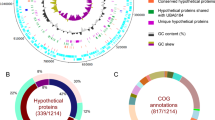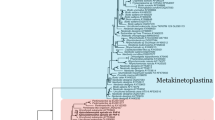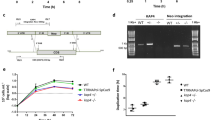Abstract
IN the course of an investigation of the occurrence of two paths of lysine biosynthesis1,2, tracer and enzyme experiments provided evidence that the trypanosomatid flagellate, Crithidia (Strigomonas, Herpetomonas) oncopelti, contains a bacterial endosymbiote3,4. This evidence was supported by electron microscopy : the inferred endosymbiote shows structures consistent with a cytoplasmic membrane, a cell wall, and nuclear zones, and endosymbiotes which are dividing, as judged by the presence of a constriction, exhibit membrane septa4,5. The protozoon can be ‘cured’ of its endosymbiote with penicillin4,5. It was suggested that the endosymbiote furnishes lysine and probably other metabolites to the protozoon, which in turn provides a protective environment for the endosymbiote3,4. This suggestion took into account: (a) the exceptionally simple nutritional requirements of the protozoon, which were recorded by Newton6; (b) the presence of ‘bipolar bodies’ within the protozoon, which were described by Newton and Horne7 and afterwards recognized as the endosymbiote3,4. Attempts to demonstrate deoxyribonucleic acid (DNA) in the bipolar bodies had given inconclusive results7.
This is a preview of subscription content, access via your institution
Access options
Subscribe to this journal
Receive 51 print issues and online access
$199.00 per year
only $3.90 per issue
Buy this article
- Purchase on Springer Link
- Instant access to full article PDF
Prices may be subject to local taxes which are calculated during checkout
Similar content being viewed by others
References
Vogel, H. J., Nature, 189, 1026 (1961).
Vogel, H. J., in Symp. Evolutionary Biochemistry, Fifth Intern. Cong. Biochem., Moscow, 1961 (Pergamon Press) (in the press).
Gill, J. W., and Vogel, H. J., Biochim. Biophys. Acta, 56, 200 (1962).
Gill, J. W., and Vogel, H. J., J. Protozool., 10 (in the press).
Gill, J. W., and Vogel, H. J., J. Protozool., 9 (Supp.), 18 (1962).
Newton, B. A., Nature, 177, 279 (1956).
Newton, B. A., and Horne, R. W., Exp. Cell Res., 13, 563 (1957).
Schildkraut, C. L., Marmur, J., and Doty, P., J. Mol. Biol., 4, 430 (1962).
Schildkraut, C. L., Mandel, M., Levisohn, S., Smith-Sonneborn, J. E., and Marmur, J., Nature, 196, 795 (1962).
Marmur, J., and Doty, P., J. Mol. Biol., 5, 109 (1962).
Marmur, J., J. Mol. Biol., 3, 208 (1961).
Smith-Sonneborn, J., Green, L., and Marmur, J., Nature, 197, 385 (1963).
Author information
Authors and Affiliations
Rights and permissions
About this article
Cite this article
MARMUR, J., CAHOON, M., SHIMURA, Y. et al. Deoxyribonucleic Acid Type attributable to a Bacterial Endosymbiote in the Protozoon Crithidia (Strigomonas) oncopelti. Nature 197, 1228–1229 (1963). https://doi.org/10.1038/1971228a0
Issue Date:
DOI: https://doi.org/10.1038/1971228a0
Comments
By submitting a comment you agree to abide by our Terms and Community Guidelines. If you find something abusive or that does not comply with our terms or guidelines please flag it as inappropriate.



